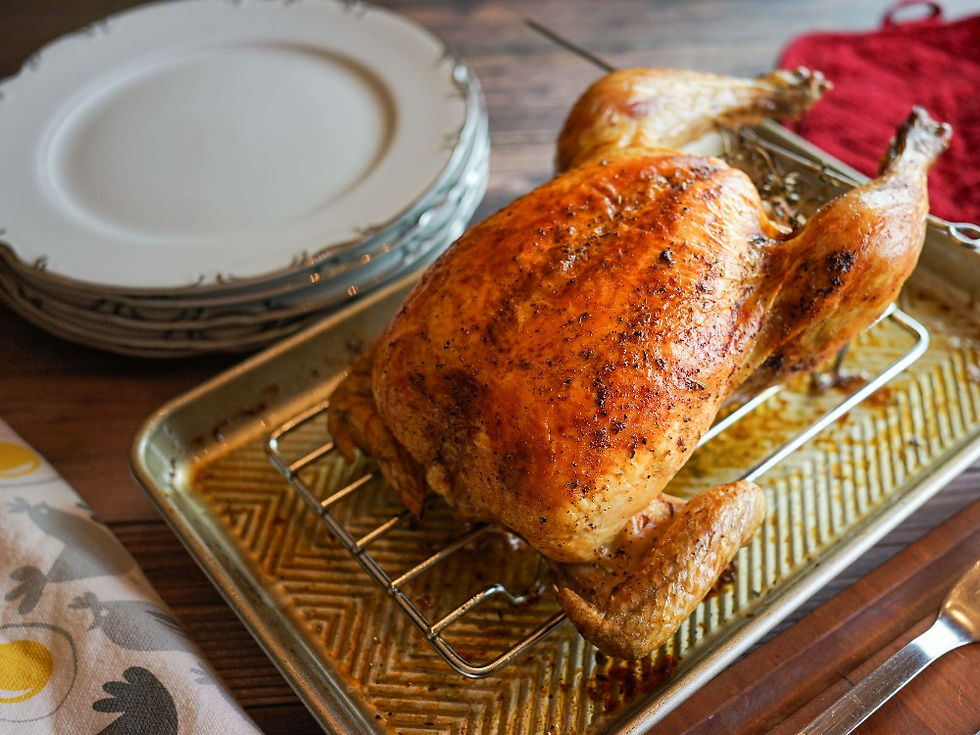Perfect Roast Chicken and Prime Rib in the Convection Roast
- Larissa Taboryski
- Aug 3, 2022
- 3 min read
Updated: Aug 17, 2022
If an oven only has three heating elements what makes the Convection Roast mode different from the Convection Bake mode?
Well in this mode the same heating elements are used but they cycle on with maximum intensity to bring more power into the oven. This mode is ideal for roasting lean tender cuts of meat, cooking multiple dishes at one time, and for braising in a covered pan.

What are the Benefits of Roasting in Convection?
Whether you are roasting a chicken or cooking an entire oven meal, engaging the Convection fan will distribute the heat evenly in the oven providing all the benefits of Convection cooking.
Large cuts of meat cook faster than normal recipe time in this mode and do not require basting or turning. Meats cooked in Convection have better moisture retention and with a dry rub of Kosher salt and your preferred seasoning, they will be very flavorful.
Because of the excellent moisture retention characteristic of Convection roasting, it is not necessary to brine meats when roasting in Convection. If your recipe calls for a particular flavor that can be achieved by brining, then use the Roast or Bake mode. The direct heat from these modes has a more drying effect on foods which will ensure a better result.

Tips for Success when Roasting in Convection
Because Convection cooks food from the edge to the center to avoid uneven cooking, use a high temperature for 10 - 15 minutes at either the beginning or end of the roasting time but use moderate temperatures of 325 - 350 degrees for the cooking.
Always arrange the oven racks prior to heating the oven and definitely heat the oven before adding food. Large cuts of meat, especially poultry, are best cooked on a rack in a shallow pan so the heated air can circulate evenly around the meat. When the meat rests directly on the pan the heat of the pan leeches moisture from the meat so that rack makes all the difference in persevering moisture which ensures better flavor and texture.
The exception would be when cooking a bone in Prime Rib or Rack of Lamb, as the meat won’t be touching the pan.
Quick cooking cuts of meat, fish, and vegetables can be placed directly on a shallow rimmed baking pan.
Timing - Meat Probes and Digital Thermometers are a Must
When roasting in this mode large roasts will cook faster than the stated recipes time so for best results use the oven meat probe if your oven features one. When estimating the cooking time be sure to add on the resting and carving time to better orchestrate the preparation of all the dishes. You don’t want the side dishes sitting around getting cold while the meat is resting.
If your oven doesn’t have a meat probe, consider a digital meat thermometer that will give you an accurate read-out or an Instant read thermometer you can use to check the degree of doneness part way through the cooking. When programming in the target internal temperature, for best results choose a slightly lower internal temperature, not the finished temperature because the internal temperature will continue to rise as the meat rests.
More Resources for Learning about Convection Roasting
To learn more about roasting in Convection, check out the Playlist for Convection Meals and of course the all-important Thanksgiving video. Once you understand how Convection can work for you I really believe you will find meal preparation much easier.
Stay Tuned for my next post that will provide a detailed explanation of the Convection Broil Mode

In the meantime, visit my Convection Recipe page for recipes, video recipes, and tips using the Convection Roast mode as well as recipes and guidelines for cooking a complete meal in Convection. You will find recipes to guide you for roasting Chicken, Prime Rib, and Turkey, as well as Tri Tip, Pork Loin Roast, and Lamb as well as recipes for cooking a complete meal in Convection.
Larissa, Your Convection Enthusiast




Comments